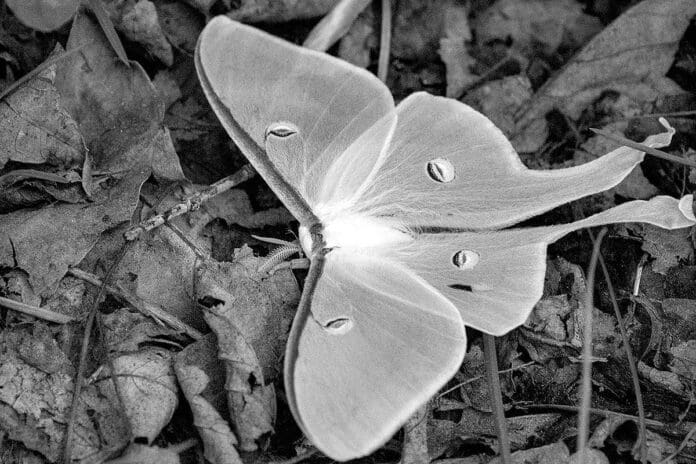By Justin Wheeler, Scott Hoffman Black, Deborah Seiler
Leaves are habitat, not trash
One of the most valuable things you can do to support pollinators and other invertebrates is to provide them with the shelter they need to survive the winter. Thankfully, that’s pretty easy; all you need to do is do less yard work.
Leaves, brush piles, fallen logs, plant stems, and flower heads might not be growing anymore, but they aren’t trash — they are natural homes for wildlife! A layer of leaves is vital insulation from the cold for the many animals that hide within (or in the soil beneath), like quite a few butterflies. Others, like many native bees, nest within stems, flower heads, or pieces of wood. Throwing out all of your leaves and other plant material isn’t just taking away options for shelter; there’s a good chance you’re tossing out many animals that have already settled in!
That’s why this year and every year, we are making the case for leaving the leaves. That’s not to say you can’t do any tidying up. We have tips for thoughtful autumn cleanup that still leaves space for nature. You’ll also meet just a few of the many animals you’ll be saving. Read on!
Five easy ways to protect wildlife this fall
Here are some simple ways you can help the fascinating invertebrates who may call your yard or garden home!
Leave the leaves, or move them just a bit
Leaving the leaves and other plant debris doesn’t have to mean sacrificing your yard to the wilderness. A thin layer of leaves is actually healthy for grass, but the leaves also don’t need to be left exactly where they fall. You can rake them into garden beds, around tree bases, or into other designated areas. Leaves are great for soil quality: they can suppress weeds, retain moisture, and boost nutrition. And perennial plants appreciate the extra insulation through the winter, too!
Avoid shredding leaves; let the bugs do that for you!
Shredded leaves will not provide the same cover as leaving them whole, and you may be destroying eggs, caterpillars, and cocoons along with the leaves. Instead of a mower, use a rake or blower to keep leaves intact. If you use leaves for compost, consider creating a leaf pile and allowing it to break down naturally if space allows. Millipedes, roly-polys, and other leaf-eating bugs will help and enjoy the meal! You can also add the leaves gradually to your existing compost pile.
Turn those fallen branches and logs into a brush pile habitat
Instead of trashing pieces of wood, stack them up! Plenty of insects seek out fallen pieces of wood to hibernate in. Piles can be as big or small as you have space for, and you can hide the pile behind a hedge or wildflowers to keep the yard looking clean. Logs and stumps can also be used as borders around a native planting area to add definition to the space.
Leave the soil (and sleeping bees) undisturbed
Approximately 70 percent of all bee species nest in the ground, frequently in yards and garden beds. If you’re planning on planting a cool season cover, a winter crop, or just moving perennials around, try to keep any disturbances as limited and shallow as possible to avoid destroying native bee nests. If that’s not possible, try to keep an eye out for groups of nests, and place markers so that you can avoid them while working in your garden.
Wait until spring is underway to trim stems and clean up
Instead of cutting back everything at the end of summer, leave the stems of perennial plants. The seed heads will feed goldfinches and other birds, and the stems will provide shelter for many insects that nest in them.
While the idea is to “leave the leaves” permanently—for all of the benefits mentioned above— if you do decide you need to remove the leaves next season, make sure you wait to clean up the garden until late in the spring so as not to destroy all the life you’ve worked to protect.
Leave the leaves and spread the word
Your garden’s wild residents benefit immensely when you practice good neighbor relations, leaving things a little messy and wild. After all, when you think of what these animals need, it is best to visualize the natural areas where they have evolved. Natural areas are not manicured, sticks and leaves are not “cleaned up” and removed, grasses grow long, seed heads are left for songbirds to feed on, and seeds can fall where they might germinate.
Of course, this can be a hard pill to swallow! It may be habitual, a matter of social conditioning, or a holdover of outdated gardening practices from yesteryear—but for whatever reason, we just can’t seem to stop ourselves from wanting to tidy up the garden at the end of the season. Changing that starts with knowledge.
So let your friends, neighbors, and social media circle know that they can also just #LeaveTheLeaves! Your yard is playing an important role in the ecosystem all year round, and it’s easy to find a compromise between a functional space for you and one that provides for wildlife. By simply doing fewer chores in the fall (and say, enjoying a steaming cup of spiced cider instead, courtesy of pollinators), your garden will reap the rewards of abundant pollination, natural pest control, and food for visiting birds and wildlife next spring.
Reprinted with permission from the Xerces Society for Invertebrate Conservation.
Learn more at xerces.org.



